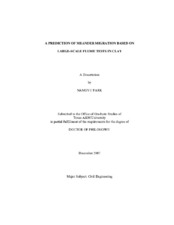| dc.description.abstract | Meander migration is a complex and dynamic process of the lateral movement of
a river due to erosion on one bank and deposition on the opposite bank. As a result, the
channel migrates in a lateral direction, which might be a major concern for the safety of
bridges during their life span of 75 years. Although there are several existing models for
predicting meander migration of a river, none of them are based on the physical model
tests on a specific type of soil.
A total of eight flume tests are conducted to develop a prediction equation of
meander migration in clay. The test results of migration rate follow a hyperbolic
function, and spatial distribution of the maximum migration distance is fitted with the
Pearson IV function. The proposed equations of the initial migration rate and the
maximum migration distance, obtained by a multiple regression technique, are validated
with the laboratory data.
A new methodology for risk analysis is developed to process a number of
predicted channel locations based on each future hydrograph generated in such a way that all the hydrographs have the same probability of occurrence. As the output from risk
analysis, a CDF map is created for a whole river representing a general trend of
migration movement along with the probability associated with new location of the river.
In addition, a separate screen is generated with a CDF plot for a given bridge direction
so that bridge engineers can read a specific migration distance along the bridge
corresponding to the target risk level (e.g. 1 %).
The newly developed components through this research are incorporated with the
other components in the MEANDER program which is a stand-alone program and the
final outcome of the research team. Verification study of the MEANDER program is
conducted with full-scale field data at the Brazos River at SH 105, Texas. The prediction
results matched quite well with the measured field data. However, a more extensive
verification study for other sites is highly recommended. | en |


